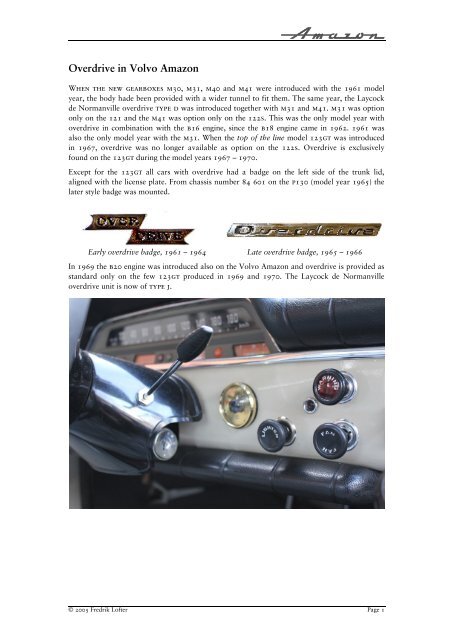
The sportier " S" models had twin-carbureted, high compression engines, typically making around 100hp. On pressing the "overdrive" switch on the shifter at cruising speed, the "D-type" Laycock de Normanville overdrive assembly would engage a higher gear effectively, a Laycock overdrive unit is a self-contained 5th gear bolted to the outside of a 4-speed transmission.
#Volvo laycock overdrive parts manual
The Amazon first came with a B16 inline four cylinder engine and a 3-speed manual transmission, but over the model's long life it was also eventually offered with the B18 and B20 engine, as well as a 4-speed manual M40, 4-speed manual with overdrive M41, or 3-speed automatic BW35 transmission.Īs with many other Volvos from the late 1950s through the 1970s, "overdrive" in cars with this option was a separate overdrive unit attached to the rear of the transmission, between the transmission and the driveshaft. The Volvo Amazon was the first car in the world to carry this lifesaving technology as standard, and seatbelts soon spread both to other cars in Volvo's lineup and (thanks to an open, freely-available patent) other manufacturers' cars as well. We've seen some USA examples of the Amazon as early as 1956, but the model's official North American debut was at the International Automobile Show in New York in 1959.Īlso arriving in 1959 was a new piece of equipment, pioneered by Volvo engineer Nils Bohlin: the three point safety belt. We thus commonly refer to this car as the Amazon, but models came badged as: This new car, now also available as a 4-door sedan and a 5-door wagon, was originally supposed to be called the Amason, but due to a copyright conflict with a German motorcycle company that had a similarly-named model, Volvo only called it the Amazon for the domestic Swedish market, instead introducing its 3-digit naming scheme internationally as the 120-series. Add in a growing global demand for bigger cars, and Volvo felt the time was right for a larger successor to the venerable PV444/544.


In the late 1950s, the PV544 remained a popular model for Volvo, but the age of its WWII-era underpinnings was becoming very apparent.


 0 kommentar(er)
0 kommentar(er)
